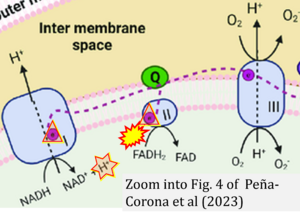Pena-Corona 2023 Front Pharmacol
| Peña-Corona SI, Hernández-Parra H, Bernal-Chávez SA, Mendoza-Muñoz N, Romero-Montero A, Del Prado-Audelo ML, Cortés H, Ateşşahin DA, Habtemariam S, Almarhoon ZM, Abdull Razis AF, Modu B, Sharifi-Rad J, Leyva-Gómez G (2023) Neopeltolide and its synthetic derivatives: a promising new class of anticancer agents. Front Pharmacol 14:1206334. https://doi.org/10.3389/fphar.2023.1206334 |
Pena-Corona SI, Hernandez-Parra H, Bernal-Chavez SA, Mendoza-Munoz N, Romero-Montero A, Del Prado-Audelo ML, Cortes H, Atessahin DA, Habtemariam S, Almarhoon ZM, Abdull Razis AF, Modu B, Sharifi-Rad J, Leyva-Gomez G (2023) Front Pharmacol
Abstract: Being the first or second cause of death worldwide, cancer represents the most significant clinical, social, and financial burden of any human illness. Despite recent progresses in cancer diagnosis and management, traditional cancer chemotherapies have shown several adverse side effects and loss of potency due to increased resistance. As a result, one of the current approaches is on with the search of bioactive anticancer compounds from natural sources. Neopeltolide is a marine-derived macrolide isolated from deep-water sponges collected off Jamaica's north coast. Its mechanism of action is still under research but represents a potentially promising novel drug for cancer therapy. In this review, we first illustrate the general structural characterization of neopeltolide, the semi-synthetic derivatives, and current medical applications. In addition, we reviewed its anticancer properties, primarily based on in vitro studies, and the possible clinical trials. Finally, we summarize the recent progress in the mechanism of antitumor action of neopeltolide. According to the information presented, we identified two principal challenges in the research, i) the effective dose which acts neopeltolide as an anticancer compound, and ii) to unequivocally establish the mechanism of action by which the compound exerts its antiproliferative effect.
• Bioblast editor: Gnaiger E
Correction: FADH2 and Complex II
- FADH2 is shown as the substrate feeding electrons into Complex II (CII). This is wrong and requires correction - for details see Gnaiger (2024).
- Gnaiger E (2024) Complex II ambiguities ― FADH2 in the electron transfer system. J Biol Chem 300:105470. https://doi.org/10.1016/j.jbc.2023.105470 - »Bioblast link«
Hydrogen ion ambiguities in the electron transfer system
Communicated by Gnaiger E (2023-10-08) last update 2023-11-10
- Electron (e-) transfer linked to hydrogen ion (hydron; H+) transfer is a fundamental concept in the field of bioenergetics, critical for understanding redox-coupled energy transformations.
- However, the current literature contains inconsistencies regarding H+ formation on the negative side of bioenergetic membranes, such as the matrix side of the mitochondrial inner membrane, when NADH is oxidized during oxidative phosphorylation (OXPHOS). Ambiguities arise when examining the oxidation of NADH by respiratory Complex I or succinate by Complex II.
- Oxidation of NADH or succinate involves a two-electron transfer of 2{H++e-} to FMN or FAD, respectively. Figures indicating a single electron e- transferred from NADH or succinate lack accuracy.
- The oxidized NAD+ is distinguished from NAD indicating nicotinamide adenine dinucleotide independent of oxidation state.
- NADH + H+ → NAD+ +2{H++e-} is the oxidation half-reaction in this H+-linked electron transfer represented as 2{H++e-} (Gnaiger 2023). Putative H+ formation shown as NADH → NAD+ + H+ conflicts with chemiosmotic coupling stoichiometries between H+ translocation across the coupling membrane and electron transfer to oxygen. Ensuring clarity in this complex field is imperative to tackle the apparent ambiguity crisis and prevent confusion, particularly in light of the increasing number of interdisciplinary publications on bioenergetics concerning diagnostic and clinical applications of OXPHOS analysis.
Labels: MiParea: Pharmacology;toxicology Pathology: Cancer




